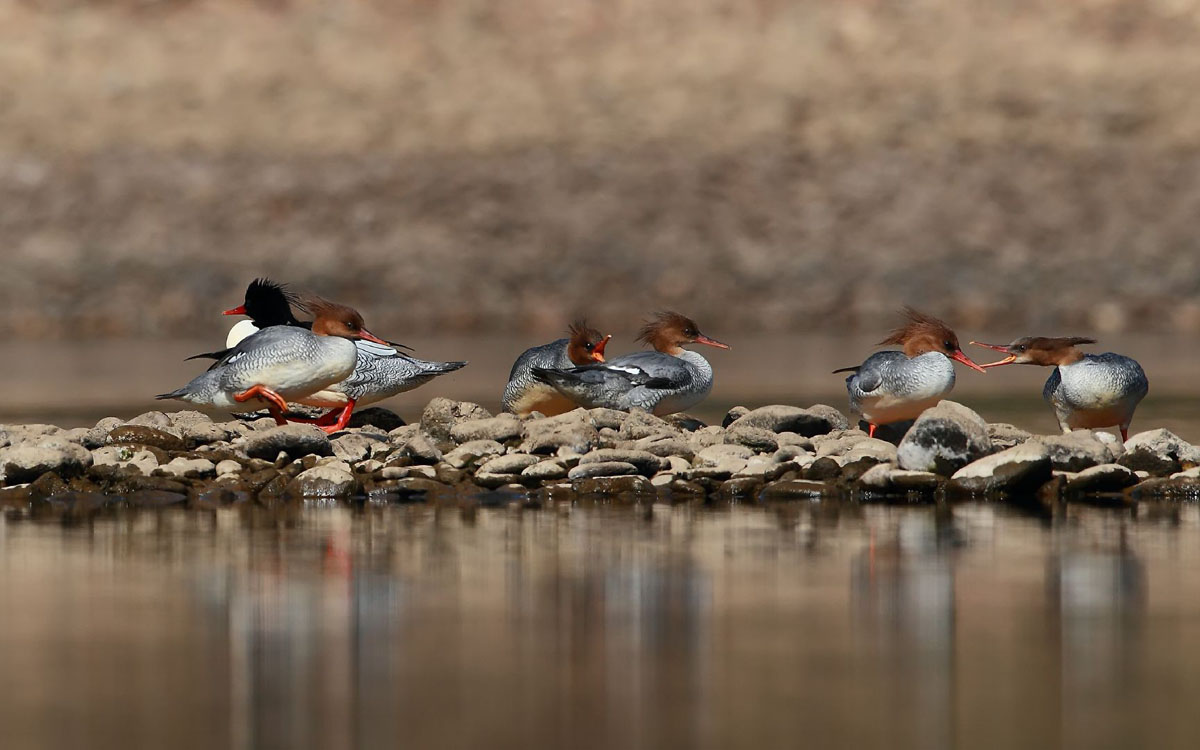Mergus squamatus
IUCN
LCBasic Information
Scientific classification
- name:Mergus squamatus
- Scientific Name:Scaly-sided Merganser,Mergus squamatus,Chinese Merganser,Scaly-sided Merganser
- Outline:Waterfowl
- Family:Anseriformes Anatidae Merganser
Vital signs
- length:49-63cm
- Weight:800-1170g
- lifetime:
Feature
A species endemic to China, with red beak and legs
Distribution and Habitat
In China, it breeds in the northeast, passes through the east and central regions, and winters in the Yellow River, Yangtze River, and Pearl River basins in the central and southern regions. It occasionally winters in the Yalu River basin in the northeast and Taiwan Island. Abroad, it breeds in the Russian Far East and the northern part of the Korean Peninsula, and winters in the Korean Peninsula, Japan, and Southeast Asia.
It likes to breed in tree holes in forests with many streams, and winters in rivers, lakes, and reservoirs. Multiple individuals often cooperate in fishing.
Appearance
The male has a black head and neck with a green luster, a long crest, a black back, white underparts and prothorax, and obvious black scaly spots on both sides. The female has a chestnut brown head and neck, a shorter crest, dark brown eye and eye pattern, gray-brown upper body, white chin, throat, prothorax and underparts, and scaly spots on both sides. The iris is brown, the beak is narrow and long with a hook at the tip, bright red, with a bright yellow tip, and orange-red feet.
Details
The Chinese merganser is a winter guest in Suzhou, China. In late autumn, it migrates from the north to the reed ponds in the Taihu Lake Basin to avoid the cold and overwinter. Usually, the Chinese merganser moves in a family manner and only gathers in large groups before migration. They merge with various wild ducks into tens of thousands of large groups, floating and wandering on the lake, playing and hunting fish. The momentum is magnificent and spectacular, just like a large-scale and noisy duck market. They have sharp eyes and high vigilance. If they sense something strange, they will quickly swim to the lakeshore and hide; at night, they sleep in the reeds or on the trees on the shore, turning their heads to the back and inserting them under their wings, looking leisurely and contented.

After migrating to Changbai Mountain in spring, they quickly disperse from the cluster state and move in the form of family and male-female pairs, and usually keep a certain distance between families. Subadults and individuals not involved in reproduction will choose to live in river sections with relatively gentle water flow, while adults who have successfully paired will choose to live in river sections not far from their nests, usually with many sturdy old broad-leaved trees on the shore. They rarely call, unlike mallards and spot-billed ducks. Their bodies have a better streamlined structure, so they fly faster than other ducks.
They live in pairs or in family groups. They dive to prey on fish. They are alert and will hold their heads high and shrink their necks if they are slightly startled. Then they will take off or swim quickly to a hidden place. They often move in small groups of 3-5, sometimes mixed with mandarin ducks. They mostly forage in slow-flowing deep waters. Before diving, they leave the water with their upper chests and then dive into the water with their heads tilted. They are active for a long time during the day. After catching a fish, they will first take it out of the water and swallow it. They mainly feed on fish, moths of the family Caddisidae, and beetles.

The Chinese merganser nests in trees, in the tree holes of sturdy living broad-leaved trees, which are generally more than 10 meters from the ground. Within one or two days after hatching, the chicks of the Chinese merganser must jump out of the tree holes and quickly enter the water, so the Chinese merganser usually chooses trees close to the water to build nests. For the Chinese merganser, the water is much safer than the land.
In the past, the Chinese merganser was widely recorded in China for wintering, but the distribution points were scattered, and most of them were small groups or scattered individuals. It was rare to see more than 10 individuals in the same place. A total of 28 waterbirds were recorded in the winter of 1989-1990, including 6 in Yancheng, Jiangsu, 17 in Gaobao Lake, 4 in Dongting Lake, and 1 in Dandong; a total of 20 were recorded in 1990-1991, including 4 in Lanzhou, 12 in Jiangsu beach, and 4 in Dongting Lake. It can be seen that the number of them in the wintering grounds is very scarce.

The Chinese merganser is a species that survived the Tertiary glacial period. It is more than 10 million years old. It is a rare bird endemic to China and a national first-class protected animal. The number is extremely rare. The Chinese merganser is an internationally endangered animal that is rarer than the Yangtze alligator.
Listed in China's "National Key Protected Wildlife List" (February 5, 2021) at level one.
In August 2022, the Qinghai Provincial Forestry and Grassland Bureau announced at a provincial bird protection and management press conference that the Chinese merganser, a national first-class key protected wild animal, is a rare bird species that has been recorded in Qinghai but not recorded in images.








